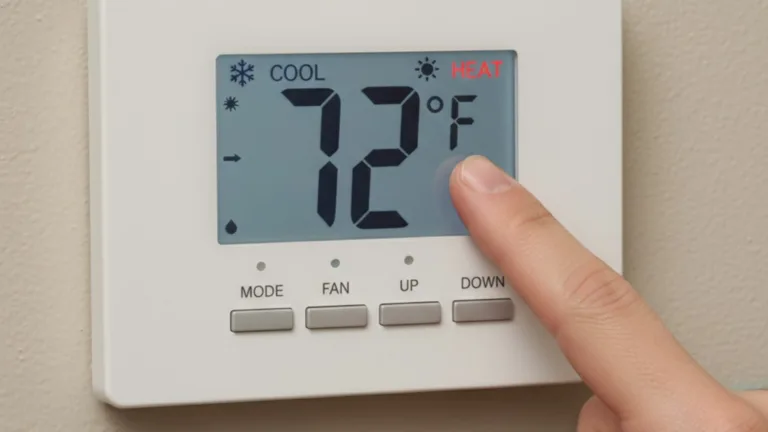So, you finally flipped your thermostat from cool to heat — just like we recommended in our fall HVAC checklist — but… nothing happens. No warm air, no comforting hum from the furnace, maybe just a cold silence or a faint click.
Don’t panic! This happens more often than you’d think, especially during that first seasonal switch in the San Gabriel Valley, when your heating system hasn’t run for months. Before you assume the worst, there are a few simple things you can check.
Here’s what to do when your heat won’t turn on — and when it’s time to call Cypress Heating & Air Conditioning at (626) 963-9810 for expert troubleshooting.
Step 1: Double-Check the Thermostat
Start simple. Your thermostat is the command center for your entire HVAC system.
- Make sure it’s set to “Heat.” This one’s easy to overlook if you’ve recently used the “Auto” or “Cool” settings
- Bump the temperature up by 3–5 degrees above your current room temperature. Listen for the system to kick on.
- Replace thermostat batteries if you haven’t done so recently. A dying battery can cause signal issues that prevent the furnace from turning on.
If you have a smart thermostat, open the app and make sure it’s online. Sometimes Wi-Fi disruptions or software updates can reset your system’s programming.
Step 2: Check the Power Source
No heat can sometimes mean no power. Head to your home’s breaker panel and make sure the HVAC or furnace breaker hasn’t tripped. If it has, reset it once — but if it trips again, stop there. That could indicate an electrical issue that needs professional attention.
If your furnace has a power switch, usually located nearby on the wall or unit itself, make sure it hasn’t been accidentally turned off. It looks just like a regular light switch and can be easy to miss.
Step 3: Inspect the Air Filter
You’ve heard it before — a dirty filter can cause more HVAC problems than almost anything else. If your system isn’t turning on or is quickly shutting off, a clogged filter could be blocking airflow.
Pull out the old filter and hold it up to the light. If you can’t see through it, it’s time for a filter replacement. A clean filter not only helps airflow but also protects your furnace’s safety sensors from overheating and shutting the system down.
Step 4: Check the Pilot Light or Ignition
If you have a gas furnace, look through the small viewing window on the front panel. You should see a steady blue flame. If it’s out, follow the lighting instructions on the furnace panel or call a professional.
Never try to manually relight the pilot if you smell gas or hear hissing — that’s a sign of a potential leak. Turn off the gas supply and call Cypress right away.
Newer systems use an electronic ignition rather than a standing pilot. If you hear repeated clicking or short bursts without ignition, that could point to a faulty igniter or flame sensor.
Step 5: Listen and Look for Signs of Life
When you turn your system on, do you hear any humming, clicking, or fan noise? If you hear nothing at all, it could mean the blower motor or control board isn’t getting power.
If the blower starts but you only get cold air, your system may be stuck mid-cycle or having trouble igniting. In this case, don’t force it — turn off the system and call a technician before parts overheat.
Step 6: Make Sure Vents and Outdoor Units Are Clear
Blocked vents can cause your system to short cycle or overheat. Walk through your home and make sure all supply and return vents are open and unobstructed. Move furniture, rugs, or curtains if needed.
If you have a heat pump, head outside and check that the unit isn’t covered in leaves or debris. The condenser needs space to draw air — at least 2 feet of clearance on all sides.
Step 7: When to Call a Professional
If you’ve gone through these steps and your heat still won’t come on, it’s time to call the pros. Furnaces and heat pumps have built-in safety systems designed to shut down at the first sign of trouble — things like overheating, gas pressure issues, or faulty sensors.
Trying to force the system to start or repeatedly resetting it can make the problem worse.
That’s where Cypress Heating & Air Conditioning comes in. Our licensed technicians will:
- Test your thermostat and control systems
- Inspect the ignition or pilot light
- Check electrical and gas connections for safety
- Clean and calibrate sensors
- Get your heat back up and running safely
We’ve been helping homeowners across the San Gabriel Valley — from Pasadena to Glendora — stay comfortable since 1967.
Step 8: Schedule a Professional Heating Tune-Up
If your heat came back on but feels weak, uneven, or noisy, it’s a good sign your system needs maintenance. A fall tune-up can prevent these headaches before they start.
Our technicians will inspect, clean, and test every major part of your system, from the blower motor to the heat exchanger. You’ll have peace of mind knowing your furnace or heat pump is safe, efficient, and ready for the cooler months ahead.
Call Cypress Heating & Air Conditioning for Fast Heating Help
When your heat won’t turn on, skip the guesswork. The longer your system sits idle with a problem, the more likely it is to cause damage or leave you without heat on a cold San Gabriel Valley night.
Call Cypress Air at (626) 963-9810 or schedule a service visit online.








